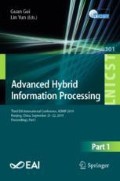Abstract
The threat of attack against deep learning based network is gradually strengthened in computer vision. The adversarial examples or images are produced by applying intentional a slight perturbation, which is not recognized by human, but can confuse the deep learning based classifier. To enhance the robustness of image classifier, we proposed several deep learning based algorithms (i.e., CNN-SVM, CNN-KNN, CNN-RF) to detect adversarial images. To improve the utilization rate of multi-layer features, an ensemble model based on two layer features generated by CNN is applied to detect adversarial examples. The accuracy, detection probability, fake alarm probability and miss probability are applied to evaluate our proposed algorithms. The results show that the ensemble model based on SVM can achieve the best performance (i.e., 94.5%) than other methods for testing remote sensing image dataset.
Access this chapter
Tax calculation will be finalised at checkout
Purchases are for personal use only
References
Gui, G., Huang, H., Song, Y., Sari, H.: Deep learning for an effective nonorthogonal multiple access scheme. IEEE Trans. Veh. Technol. 67(9), 8440–8450 (2018)
Huang, H., Yang, J., Huang, H., Song, Y., Gui, G.: Deep learning for super-resolution channel estimation and DOA estimation based massive MIMO system. IEEE Trans. Veh. Technol. 67(9), 8549–8560 (2018)
Goodfellow, I.J., Shlens, J., Szegedy, C.: Explaining and harnessing adversarial examples. In: International Conference on Learning Representations (ICLR), pp. 1–11 (2015)
Tabacof, P., Valle, E.: Exploring the space of adversarial images. In: Proceedings of International Joint Conference on Neural Networks (IJCNN), pp. 426–433 (2016)
Liang, B., Li, H., Su, M., Li, X., Shi, W., Wang, X.: Detecting adversarial image examples in deep neural networks with adaptive noise reduction. IEEE Trans. Dependable Secur. Comput. (2018). https://doi.org/10.1109/TDSC.2018.2874243
Kurakin, A., Goodfellow, I., Bengio, S.: Adversarial machine learning at scale. In: International Conference on Learning Representations (ICLR), pp. 1–17 (2017)
He, W., Wei, J., Chen, X., Carlini, N., Song, D.: Adversarial example defenses: ensembles of weak defenses are not strong (2017). http://arxiv.org/abs/1706.04701
Li, X., Li, F.: Adversarial examples detection in deep networks with convolutional filter statistics. In: IEEE International Conference on Computer Vision (ICCV), pp. 5775–5783 (2017)
Zhang, M., Li, W., Du, Q.: Diverse region-based CNN for hyperspectral image classification. IEEE Trans. Image Process. 27(6), 2623–2634 (2018)
Fawzi, A., Moosavi-Dezfooli, S.-M., Frossard, P.: Robustness of classifiers: from adversarial to random noise. In: 30th Conference on Neural Information Processing Systems (NIPS), pp. 1632–1640 (2016)
Carlini, N., Wagner, D.: Towards evaluating the robustness of neural networks. In: IEEE Symposium on Security and Privacy (SSP), pp. 39–57 (2017)
Author information
Authors and Affiliations
Corresponding author
Editor information
Editors and Affiliations
Rights and permissions
Copyright information
© 2019 ICST Institute for Computer Sciences, Social Informatics and Telecommunications Engineering
About this paper
Cite this paper
Liu, H., Li, W., Li, Z., Wang, Y., Gui, G. (2019). Deep Learning Based Adversarial Images Detection. In: Gui, G., Yun, L. (eds) Advanced Hybrid Information Processing. ADHIP 2019. Lecture Notes of the Institute for Computer Sciences, Social Informatics and Telecommunications Engineering, vol 301. Springer, Cham. https://doi.org/10.1007/978-3-030-36402-1_30
Download citation
DOI: https://doi.org/10.1007/978-3-030-36402-1_30
Published:
Publisher Name: Springer, Cham
Print ISBN: 978-3-030-36401-4
Online ISBN: 978-3-030-36402-1
eBook Packages: Computer ScienceComputer Science (R0)

